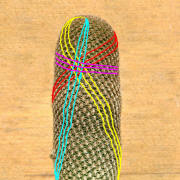|

A specimen of
Mammillaria luethyi
parastichy number 10-16 (yellow and red parastich)
|
Parastich are the apparent –
primary and secondary – spiral lines visible in the position of
a leaf (or of other
homologous
organ ), it is also used
to describe the spiral line of
areoles on the stem of
cactus.
Each of the patterns has a certain number of primary (yellow)
and secondary (red) spirals. Botanists have
classified these
patterns according to these parastichies numbers. Hence,
if a pattern has 10 primary (yellow) and 16 secondary (red)
spirals, it is said that its parastechy numbers are (10, 16):
the smallest number always goes first. Each
species is characterized by
a defined range of parastichy number. This number may
vary and increase with time from
juvenile to
adult age. |

Right: A stem of
Lobivia famatimensis v. bonnieae, it is
possible to see not only the primary (yellow) and secondary
(red) parastich but also tertiary (blue) and quaternary (violet)
|